
About UsThe Numismatic Bibliomania Society is a non-profit organization promoting numismatic literature. For more information please see our web site at coinbooks.org SubscriptionsThose wishing to become new E-Sylum subscribers (or wishing to Unsubscribe) can go to the following web page link MembershipThere is a membership application available on the web site Membership Application To join, print the application and return it with your check to the address printed on the application. Membership is only $15 to addresses in the U.S., $20 for First Class mail, and $25 elsewhere. For those without web access, write to: David M. Sundman, Secretary/TreasurerNumismatic Bibliomania
Society AsylumFor Asylum mailing address changes and other membership questions, contact David at this email address: dsundman@LittletonCoin.com SubmissionsTo submit items for publication in The E-Sylum, just Reply to this message, or write to the Editor at this address: whomren@coinlibrary.com
BUY THE BOOK BEFORE THE COINYou won't regret it! |
- WAYNE'S WORDS: THE E-SYLUM DECEMBER 2, 2012
- NEW BOOK: U.S COINS CLOSE UP
- NEW BOOK: THE EARLY COINS OF MYANMAR (BURMA)
- NEW BOOK: OPIUM WEIGHTS
- NEW BOOK: WORLD SQUARE COINS 1900-2000
- MERCANTI'S 'AMERICAN SILVER EAGLES' BOOK RATIONED BY SELLERS
- MORE ON DISPLAYING WATERMARKS
- NOTES FROM E-SYLUM READERS: DECEMBER 2, 2012
- SEATED HALF DIME LITERATURE
- QUERY: DICKENS LAND LONDON 1941 MEDALS
- ALASKA'S FIRST ESPRESSO BOOK MACHINE
- THE U.S. MINT OATH OF ALLEGIANCE MEDAL
- ON THE DEATH OF THE SILVER STANDARD
- HEMINGWAY'S LAST PENNY
- U.S. CONSIDERS REPLACING THE $1 NOTE WITH A $1 COIN
- QUERY: AL SMITH PORTRAIT MEDAL INFORMATION SOUGHT
- CANADIAN GOLD MAPLE LEAF MICRO-ENGRAVED SECURITY FEATURE
- ARTIFACTS FROM THE NUESTRA SENORA DE LAS MERCEDES
- IRELAND'S NOISY COIN-CRUSHING MACHINE
- INDIA'S ' COIN MAFIA' PROFITS FROM SMALL CHANGE SHORTAGE
- RUSSIA AIRLIFTS BANKNOTES TO SYRIA
- NEW COIN DESIGNS: DECEMBER 2, 2012
- THE KETT'S REBELLION COIN HOARD
- FEATURED WEB PAGE: NUMISTA.COM
WAYNE'S WORDS: THE E-SYLUM DECEMBER 2, 2012

New subscribers this week include R.C.Taylor, courtesy of Howard Daniel, Mary Lawrence, Michael van den Heuvel, Bob Kebler, and ANS membership coordinator Viviana Londono. Welcome aboard! We have 1,613 email subscribers, plus 202 followers on Facebook.
This week we open with information on four new numismatic books and background on why it can be hard to find new titles in the bookstores. Other topics include displaying watermarks, half dime literature, Al Smith, Dickens Land and the death of the silver standard.
To learn more about The U.S. Mint Oath of Allegiance medal, the Indian coin mafia, Hemingway's last penny, Ireland's coin-crushing machine, and vegetable oil in numismatics, read on. Have a great week, everyone!
Wayne Homren
Editor, The E-Sylum
NEW BOOK: U.S COINS CLOSE UP
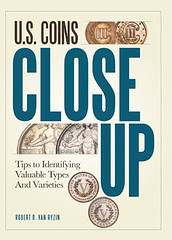 U.S. Coins Close Up is a type guide to regular-issue U.S. coins from half cents through double eagles. Each listing provides information as to designer, years of issue, weight and size, metal, an actual-size photo of the type and an a paragraph providing additional information about the type and the various popular or low mintage dates and varieties that can be found.
U.S. Coins Close Up is a type guide to regular-issue U.S. coins from half cents through double eagles. Each listing provides information as to designer, years of issue, weight and size, metal, an actual-size photo of the type and an a paragraph providing additional information about the type and the various popular or low mintage dates and varieties that can be found.
The final 75 or so pages provide the “close up” aspect, with digital microscope images of genuine and altered coins (including diagnostics for the 1877 Indian Head cent and 1909-S V.D.B. Lincoln cent, and examples of counterfeits and altered dates, such as a high quality die-struck counterfeit 1972 doubled-die cent), characteristics of various popular varieties (large and small dates, large and small mottoes, etc.) and visual depictions of standard hobby terms relating to the minting process (such as die polish, die clashes, and adjustment marks).
It’s 5 ½ by 7 ½, soft cover, b + w images, $17.99 cover price, paperback, 256 pages. Currently listing at www.shopNumisMaster.com at $10.79.
U.S. Coins Close Up
Tips to Identifying Valuable Types and Varieties
Format: Paperback
Take a Closer Look
Is that coin in your hand the real deal or a clever fake? Discover the difference with U.S. Coins Close Up, a one-of-a-kind visual guide to every U.S. coin type. This handy reference features large and clear images that detail inscriptions, mintmarks and initials, as well as thorough descriptions and fascinating coin history.
Author and renowned numismatist Robert R. Van Ryzin takes a keen and careful look at U.S. coins, with in-depth denomination overviews, highlights of remarkable coins and an extended glossary of terms and features. No matter your level of expertise, this invaluable resource will leave you more knowledgeable and better prepared to spot that carefully altered coin – and save you from making an expensive mistake.
For more information, or to order, see: www.shopnumismaster.com/us-coins-close-up-w7621
NEW BOOK: THE EARLY COINS OF MYANMAR (BURMA)
 ISBN 978-974-480-191-3
ISBN 978-974-480-191-3
WL Order Code 22 675
US $50.00
Bangkok 2012, 192 pp., illus. 15 pp. in col., 1 map,
215 x 295 mm,
Weight 0.900 grams
Mahlo, Dietrich : The Early Coins of Myanmar(Burma) Messengers From the Past

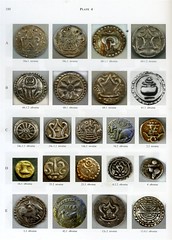
To order from White Lotus books, see: www.whitelotusbooks.com/bookdetail.php?id=E22675
NEW BOOK: OPIUM WEIGHTS
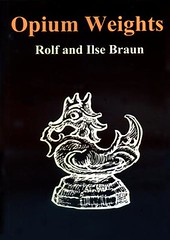 WL Oder Code N4108
WL Oder Code N4108
US $22.00
Bangkok 2012 66 pp., illus., 145 x 210 mm, pbk.
Weight 0.290 grams
Braun, Rolf & Ilse; Opium Weights
Bookseller Diethard Ande writes:
The Opium Weight book is an English reprint from an earlier version in three languages (German, French and English) This one is reduced in size and only in English. Privately produced in Burma. This book was a standard work for some decades and was long out-of-print and only available in Burma as photo copy. It is identical to the original with the exception that it is smaller and only in English
To order from White Lotus books, see: www.whitelotusbooks.com/bookdetail.php?id=N4108
NEW BOOK: WORLD SQUARE COINS 1900-2000
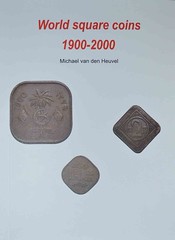 My name is Michael van den Heuvel. I am a member of the Central States Numismatic Society and I just wrote a small book about world square coins from 1900 to 2000. The book is over 80 pages and covers all 26 countries and territories that had square coins in that period. Among others Aruba, Bahamas, Bangladesh, Belgium, Ceylon, Curacao, Eastern Caribbean States, Guernsey, India, Iraq and many more.
My name is Michael van den Heuvel. I am a member of the Central States Numismatic Society and I just wrote a small book about world square coins from 1900 to 2000. The book is over 80 pages and covers all 26 countries and territories that had square coins in that period. Among others Aruba, Bahamas, Bangladesh, Belgium, Ceylon, Curacao, Eastern Caribbean States, Guernsey, India, Iraq and many more.
In the book there are photos of all the different types of square coins, descriptions, weight, mintage, metal composition and when possible also information about the design and designer of the coins. Also it has some new information that has not been published before in any catalogue, such as the mintage of the 25 Ghirs of Sudan. Variations for the 1966 square coins of Suriname and even coins that are not in any other catalogue such as the 5 Poisha from Bangladesh 1978.
I wrote the book not to make a profit, but because I love the research involved in the project and would like numismatic researchers have a copy of it.
It took me over a year and 38 letters to find out how many 25 Ghirsh from Sudan where possibly minted, since the national bank does not have the information, the country is more or less at war and the staff of the national mint has been changed a few times since 1987. When I finally got in contact with a person that used to work at the mint in 1987, he did not know how many they made but could tell me that they used almost all "planchets" and they were bought in the UK. Then I started to find out how many where made in the UK and exported to Sudan.
The retail price is $10 U.S. dollars + $6 U.S. postage. However, readers of The E-Sylum can get a 30 % discount on the book as long as they write the E-Sylum code WH. So for E-Sylum readers it would be $7 U.S. + $6 U.S. postage (total $13).
For my research I did get a small grant from the Central States Numismatic Society and it is because of this that I can offer the book at cost to numismatic libraries.
I can sell the book to libraries for 4 U.S. dollars and postage 6 U.S. dollars, total price $10 U.S. If more books are ordered the shipping price will drop a lot , due to the sick way the Danish postal service works.
The book can be ordered by sending an email to info@atm-art.com and can be paid via Paypal, also to info@atm-art.com
Michael van den Heuvel
Jakobdannefærdsvej 5 1tv
1973 Frederiksberg
Denmark
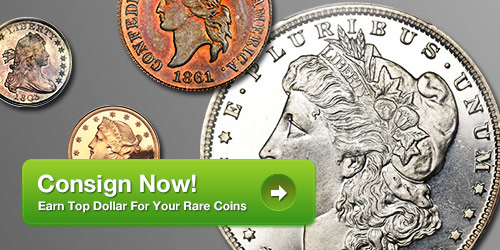
MERCANTI'S 'AMERICAN SILVER EAGLES' BOOK RATIONED BY SELLERS
I was two days late getting to a book store after the Monday, November 26th date John Mercanti's new book, American Silver Eagles was scheduled to be in book stores.
Landing at the Barnes & Nobel book store in Waterbury, Connecticut, I marched up to the service counter. "Do you have the book 'American Silver Eagles' by the author Mercanti?", and I spelled the name as he typed it in the computer. "Is his first name John?" asked the attendant -- I knew they had it in stock if they had it in their computer.
"I want four copies" I said with wife standing behind me with Christmas shopping list in hand. "We only have one copy," he replied somewhat sorrowfully and tapped some more on the computer. "There are none in the warehouse, they sent one copy to each store."
I must have expressed my disappointment. "You can go to four different stores to buy their one copy" he offered as a solution. "Let's find that one copy we have." He led off in the direction of Collectibles section. "That would be in 'Coin Collecting" wouldn't it?" "Should be."
As he stopped at that section we both started scanning book spines. "It's on the top shelf", said eagle-eyed wife. He reached up and brought down the coveted tome. Pristine copy. Probably hasn't been touched since it was placed there days earlier.
Glad I got that one copy. But wondered why only one copy per store.
I had preordered a copy from Whitman by internet earlier for myself, and I can wait for that to be delivered. But I want to mail off those others as gifts.
Book retailers like Barnes & Noble and Books-A-Million can be conservative when ordering new titles. These decisions are often made at the corporate level. They want to see a track record of solid sales before they commit their valuable shelf space to multiple copies of a book. When a store’s single copy in stock is purchased by a customer, they’ll order another to replenish it.
It’s a different story for older, established, popular titles. In the “Antiques and Collectibles” section a store might carry multiple copies of a best-seller like the Red Book, because they have years of past sales to benchmark against --- they know there will be a rush of customers when the latest edition debuts, and they know that many of their ~700 stores will sell dozens (if not hundreds) of copies over the course of a sales year.
Folks who love the experience of shopping in their favorite bookstores (count me in that group!) can always call ahead to special-order multiple copies. Shopping online also gives the option of conveniently ordering multiple copies. Whitman is offering free shipping on orders over $10 placed at www.Whitman.com through December 24th. That would include American Silver Eagles, of course. I know we’ll be having some special online offers in the coming days, including copies of the book autographed by John Mercanti. If anyone has trouble getting a copy of American Silver Eagles, they can contact me directly at dennis.tucker@whitman.com.
Dick Johnson adds:
Good Wife Shirley found two more copies at the Danbury Barnes & Noble.
To read the earlier E-Sylum article, see: NEW BOOK: AMERICAN SILVER EAGLES: A GUIDE TO THE U.S. BULLION COIN PROGRAM (www.coinbooks.org/esylum_v15n40a03.html)
MORE ON DISPLAYING WATERMARKS
Last week Dick Hanscom asked about how to highlight a watermark for display. Kerry Rodgers writes:
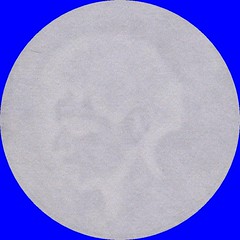 Dick Hanscom should perhaps approach whoever is producing the current crop of “replica’ banknotes being offered on eBay.
Dick Hanscom should perhaps approach whoever is producing the current crop of “replica’ banknotes being offered on eBay.
I have just seen the replica £20 George VI Fiji specimen. The Fijian head watermark in the note’s window is reproduced in disconcerting detail – quite sufficient to fool most observers. My attempt to reproduce it and here does not do justice to the skilled artisan responsible for the reproduction.
Joe Boling writes:
I can suggest a couple of approaches. First, since you showed a photo of the paper apparently without backlight, you can see that the particular watermark Dick wants to use is very prominent. It is visible with the note just sitting on a tabletop. It can be enhanced by placing it on black paper. And, since that particular paper is not scarce, if he's interested in spoiling one piece by soaking it in vegetable oil, I suspect it would be even more legible after placing it on the same black paper. When he's done with the exhibit, it's possible that the paper could be essentially restored by treating it with a degreaser. After all, it has survived five decades of submersion already.
To read the earlier E-Sylum article, see: QUERY: HOW TO HIGHLIGHT A WATERMARK FOR DISPLAY (www.coinbooks.org/esylum_v15n49a12.html)
NOTES FROM E-SYLUM READERS: DECEMBER 2, 2012
Is There an App for Counterfeit Detection?
Ginger Rapsus writes:
With all the talk about SmartPhone apps, has anyone developed an app to detect counterfeit U.S. currency? Would such an app be possible?
Bob Evans' Star Power
Donn Pearlman writes:
In response to the rhetorical question in the last issue of The E-Sylum about who should play Tommy Thompson and Bob Evans in a theatrical movie about the Ship of Gold, I suggest Bob portray himself in the film. As you can see by this photo I shot at the February 2010 Long Beach Expo, he's obviously got star power -- and a great hat for a Hollywood star to wear.
The photo is Bob holding one of the recovered gold ingots while Diandra Jay, a photographer for the Long Beach Press-Telegram, takes a close up shot.
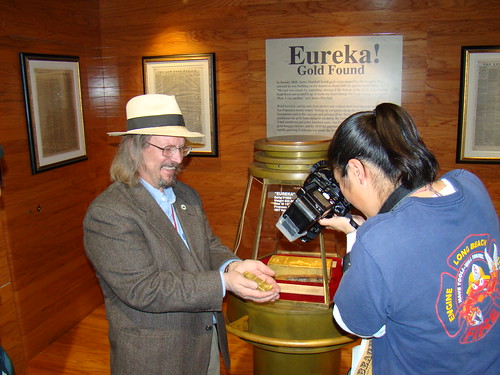
To read the earlier E-Sylum article, see: MORE ON THE SHIP OF GOLD FILM (www.coinbooks.org/esylum_v15n49a10.html)
More on Henry A. Merton
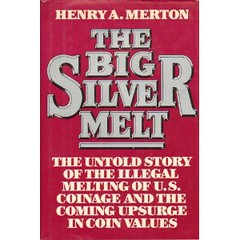 Regarding Michael Chazin's question about the author of The Big Silver Melt, Dick Doty writes:
Regarding Michael Chazin's question about the author of The Big Silver Melt, Dick Doty writes:
As far as I know, Henry Merton's still alive and well in or around Saratoga, New York. But I don't think he writes about coinage any more. It seemed to me at the time that his estimates on surviving silver had merit. Still does.
To read the earlier E-Sylum article, see: QUERY: INFORMATION ON HENRY A. MERTON SOUGHT (www.coinbooks.org/esylum_v15n49a11.html)
On Matthew Boulton and the Continental Dollar
Last week I remarked that "the Continental Currency coins do not look to me like the work of Boulton." Dick Doty (National Numismatic Collection Curator and author of The Soho Mint writes:
With respect to the Continental Dollar, Matthew Boulton never did anything that crude. Blame it on the insurgents!
To read the earlier E-Sylum article, see: MORE ON THE 1776 CONTINENTAL CURRENCY COINAGE (www.coinbooks.org/esylum_v15n49a08.html)
Howard Daniel, Big Tipper
Last week I quoted Howard Daniel's report on his Vietnam visit in World Coin News. Howard wrote: "I asked one of the waitresses how much it cost for an ice tea and she said it was free so I gave her 10,000 dong as a tip."
Gene Brandenburg writes:
It's heartwarming to see that Howard's generosity expands to other continents. As a frequent participant at Wayne's Nummis Nova dinners, while disruptive - it's always a pleasure to see Howard there. When the bill arrives, bracing oneself for the ensuing ruckus as Howard tries to pass off nearly worthless high denomination "dongs" (Vietnamese currency) is a highlight of the evening. Assuring law enforcement that his gestures are innocent has evolved into a pattern we all enjoy.
Come home safely Howard, there are still a few restaurants that will have us back.
Howard adds:
10,000 Dong is 50 cents US, which is the standard tip for one of anything in a restaurant/cafe or a taxi ride. I get yelled at by friends and relatives when I give more.
To read the earlier E-Sylum article, see: HOWARD DANIEL: BACK IN VIET NAM WITH OLD FRIENDS (www.coinbooks.org/esylum_v15n49a19.html)
SEATED HALF DIME LITERATURE
The marathon trip thus turned into a long weekend vacation, which included some time at the American Numismatic Society, where I was able to review the literature related to Liberty Seated half dimes.
The action begins in 1883, with Harold P. Newlin’s A Classification of the Early Half-Dimes of the United States. Published by John Haseltine in Philadelphia, this volume was a natural extension of Haseltine’s earlier (1881) Type Table, which enumerated die varieties of silver dollars, halves, and quarters.
The Type Table, while a starting point, did not comprehensively cover the Liberty Seated varieties, and, sad to say, Newlin did not do much better. Nor did he even make the pretense – “I do not propose to give all the varieties of the later Half-dimes,” he wrote, “for there are many, and differ so little, that it would make this article too voluminous. I leave this field for those, who, I hope, will write more at length upon this subject, and will content myself by naming only a few of the important varieties.” And that is precisely what he did, confining discussion of Liberty Seated half dimes to the major design types. With printing limited to one hundred copies, the Newlin work is thus a more appealing item to the literature specialist, than to the collector attempting seated half dime attribution.
The record goes silent until 1927, when Will W. Neil published a short article in the August, 1927 Numismatist, followed with an addenda in the December issue noting a few later discoveries. Neil’s effort is the first serious attempt at scaling the Liberty Seated half dime variety summit.
He gives descriptions of about a hundred varieties, perhaps reaching only the base camp but at least getting started. There are no plates here, and like the Beistle half dollar study of the same period, this is problematic for the collector. Some of these varieties are hard to attribute even with plates!
QUERY: DICKENS LAND LONDON 1941 MEDALS
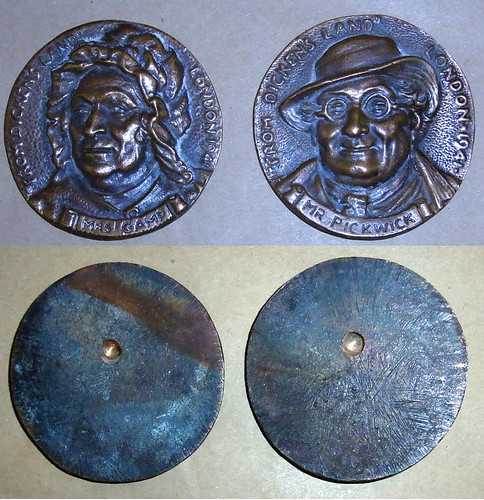
Philip Mernick of London writes:
I attach an image of two bronze medals depicting Dickensian characters. They are one-sided with a hole in the back, possibly for hanging on a hook or nail.
Both read FROM DICKENS LAND LONDON 1941. There are at least three more in the “set”. Although a number have appeared on eBay, nobody here seems to know who made them.
1941 London was not the time or place for exhibitions or medal making. Could they be American? Possibly given away with a set of books?

ALASKA'S FIRST ESPRESSO BOOK MACHINE
 With a flood of e-books entering the publishing world, the University of Alaska Fairbanks has purchased a device that combines a digital database with a traditional literary model.
With a flood of e-books entering the publishing world, the University of Alaska Fairbanks has purchased a device that combines a digital database with a traditional literary model.
The Espresso Book Machine looks like a mammoth photocopier, but it’s more like a high-tech literary vending machine. Users can pick from 3.3 million titles, which are converted on the spot into a bound paperback book.
EBM can crank out about 100 pages per minute, with a maximum book size of 500 pages. Once the pages are printed, a 350-degree glue binds it together between a cover. From beginning to end, the process takes 5 minutes or less, said the bookstore’s EBM communications manager, Kevin Lawson.
The UAF College of Rural and Community Development Bookstore is using the roughly $100,000 machine to create a new way to distribute books. Publications can vary from “The Adventures of Huckleberry Finn” to “The Roots of Ticasuk,” with the occasional batch of course catalogs thrown in.
Having a machine than can produce a variety of books on the spot also brings some advantages, bookstore manager MaryAlice Short said. There’s no need to have a warehouse full of books waiting to be sold, and the shipping cost of sending those books to rural campuses in Alaska is less when they originate from Fairbanks. Short said she expects the EBM to pay for itself through those savings.
Short said the EBM machines are fairly common on Lower 48 campuses, but it’s the only such device in Alaska. Books typically cost between $10 and $20.
Lawson said it’s also helped with the preservation of Alaska Native books that are in danger of going out of print. A book from the Dillingham area, “Yup’ik Eskimo Orthography,” had only two remaining books before EBM was able to create about 100 more copies.
To read the complete article, see:
University of Alaska Fairbanks unveils book-making machine
(newsminer.com/view/full_story/20933784/article
-University-of-Alaska-Fairbanks-unveils-book-making-machine)
THE U.S. MINT OATH OF ALLEGIANCE MEDAL
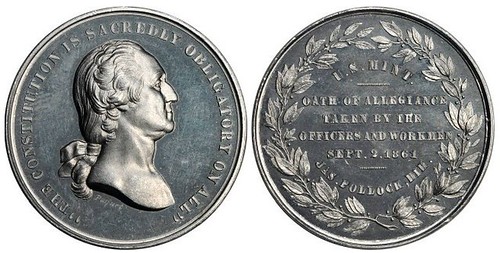
Washingtoniana collectors have a wide variety of interesting coin, medals and tokens to collect. I was reviewing medals listed at an auction site and found an interesting medal from the start of the American Civil War.
The September 2, 1861 "Oath of Allegiance" medal was used to commemorate the "allegiance to the US Constitution" requirement by US Mint officials and workers after the loss of 3 of the 5 US Mint facilities to the Confederate States of America (CSA).
The oath was to counter publicity about US Mint employees going over to the Confederacy. This was due to the fact the CSA retained all mint officials at the New Orleans Mint (6 months earlier), took control of the Dahlonega Mint (5 months earlier), and took control of the Charlotte Mint (4 months earlier).
The medal was designed by the engraver Anthony C. Paquet and attributed as Julian CM-2 and Baker 279. They were struck in gold, silver, copper and aluminum. Only 259 were struck in silver.
To read the complete article, see: Numismatic Detective -- US Mint Oath of Allegiance Medal posted by DrDarryl (boards.collectors-society.com/ubbthreads.php?ubb=showflat&Number=6177408)
ON THE DEATH OF THE SILVER STANDARD
The silver standard did not die a natural death. It was deliberately killed. A proper search for the assassins was never carried out. There was never a post-mortem. In this paper we focus on the conspiracy as it might have unfolded between the two dates: April 9, 1865 (the day General Lee of the Confederacy surrendered at Appomattox to General Grant of the Union marking the end of the War Between the States) and January 1, 1879 (Resumption Day, when payment of the victorious Union’s currency, the greenback was resumed in gold specie ̶ but not in silver).
In the 19th century silver coins did most of the money-work in the world. The turnover of silver coinage (the value of silver coins times their velocity) was at an all-time high, eclipsing the turnover of gold coinage by far. Inept governments did not follow the lead of Isaac Newton, and they tried to enforce a rigid exchange rate between the two monetary metals (called the Mint ratio). This system was called bimetallism ̶ a stillborn idea.
Bimetallism did not stabilize the exchange rate. On the contrary, it has destabilized it. The natural monetary system is based on silver and gold valued at a variable rate, as Newton’s monetary system in Britain did. Bimetallism was the disease, the demise of the silver standard was the unfortunate consequence. In the Western countries by 1879, in India by 1893, in China, the last stronghold of silver, by 1935, silver was demonetized. Between the two dates 1879 and 1935 the world witnessed a most spectacular event: the collapse of the value of silver by more than 80% in a little over half of a century. Silver fell from $1.29/oz in 1873 to 25¢/oz in 1935. Putting it differently, the gold/silver price ratio rose from 15:1 to more than 80:1. Never in history, ancient or modern, have markets put such fancy values on gold in terms of silver.
All this can be neatly explained in terms of the Quantity Theory of Money. The richest silver vein ever, called the Comstock Lode was discovered in Nevada in 1858. Surplus silver inundated the economy and lost most of its value due to the oversupply and the lack of matching demand.
But this explanation will not satisfy those of us who consider the Quantity Theory of Money as a mere mechanical metaphor. As a theory it is bound to fail because it is trying to give a linear explanation of highly non-linear phenomena. January 1, 1879, Resumption Day, when the payment of the greenback in gold (but not in silver) specie was resumed, coincided with the date when the Latin Monetary Union in Europe closed its last Mint to silver ̶ marking the end of the silver standard in the Western countries. The coincidence is ominous.
No satisfactory explanation has been offered in the literature for the fact that the closing of the Mints to the free coinage of silver was the starting point of an unprecedented destruction of wealth world-wide, due to the relentless fall in the price of silver during the following 55 years.
To read the complete article, see: THE INCREDIBLE COLLAPSE OF THE VALUE OF SILVER COINS IN THE 19TH CENTURY ̶ DON’T BLAME COMSTOCK! (www.silverseek.com/article/silver-saga-7861)
HEMINGWAY'S LAST PENNY
Ron Abler writes:
 I recently returned from a week in the Florida Keys with my wife. One of our touring targets was to visit Hemingway House in Key West. Who knew there’d be a numismatic connection?
I recently returned from a week in the Florida Keys with my wife. One of our touring targets was to visit Hemingway House in Key West. Who knew there’d be a numismatic connection?
Back in the 1930s, when Ernest Hemingway built his Key West home, he designed an in-ground swimming pool. It was to be an engineering and architectural feat. A hole 24 feet wide, 60 feet long, and 5-10 feet deep had to be cut out of solid coral. While Hemingway was off covering the Spanish Civil War, his wife Pauline was left to supervise the project to completion. Upon his return in 1938, the pool was finished, at a cost of $20,000, a princely sum in those days.
Hemingway chided his wife over the exorbitant price tag, saying “Pauline, you’ve spent all but my last penny, so you might as well have that!” As he said it, he flung a penny down onto the as yet incomplete flagstone patio surrounding the pool. It turns out that Pauline had a sense of humor, or at least of resignation, because she had the penny embedded in cement next to a patio post at the north end of the pool. That penny is still there to this day – a 1934 Lincoln cent.
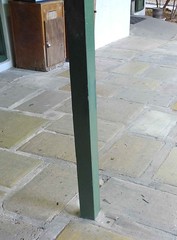
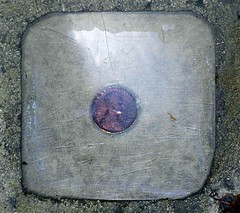
To read the earlier E-Sylum article, see: FIRST SLABBED COIN? (www.coinbooks.org/esylum_v06n01a16.html)
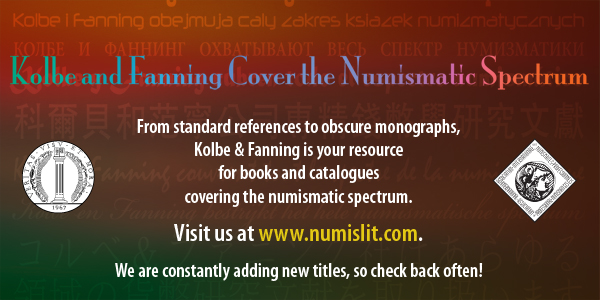
U.S. CONSIDERS REPLACING THE $1 NOTE WITH A $1 COIN
In our prior reports, we recommended that Congress proceed with replacing the $1 note with the $1 coin. We continue to believe that replacing the note with a coin is likely to provide a financial benefit to the government if the note is eliminated and negative public reaction is effectively managed through stakeholder outreach and public education. However, we realize that replacing the $1 note with the $1 coin is controversial. We have previously reported on public opposition to using the $1 coin and the challenges that private businesses such as vending machine owners would face if such a transition were undertaken. Several foreign countries have already transitioned from small note denominations to coins, for a number of reasons, including the greater durability of coins and inflationary pressures.
Over the last 48 years, Australia, Canada, France, Japan, the Netherlands, New Zealand, Norway, Russia, Spain, and the United Kingdom, among others, have replaced lower-denomination notes with coins. The rationales for replacing notes with coins cited by foreign government officials and experts include the cost savings to governments derived from lower production costs and the decline over time of the purchasing power of currency because of inflation.
Stopping production of the note and actions to overcome public resistance have been important in Canada and the United Kingdom as the governments transitioned from a note to a coin. While observing that the public was resistant at first, Canadian and United Kingdom officials said that with the combination of stakeholder outreach, public relations efforts, and ending production and issuance of the notes, public dissatisfaction dissipated within a few years. Canada undertook several efforts to prepare the public and businesses for the transition to the coin. For example, the Royal Canadian Mint reached out to stakeholders in the retail business community to ensure that they were aware of the scope of the change and surveyed public opinion about using coins instead of notes.
To read the complete article, see: Benefits and Considerations for Replacing the $1 Note with a $1 Coin (www.gao.gov/assets/660/650373.pdf)
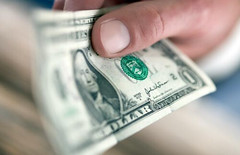 American consumers have shown about as much appetite for the $1 coin as kids do their spinach. They may not know what's best for them either. Congressional auditors say doing away with dollar bills entirely and replacing them with dollar coins could save taxpayers some $4.4 billion over the next 30 years.
American consumers have shown about as much appetite for the $1 coin as kids do their spinach. They may not know what's best for them either. Congressional auditors say doing away with dollar bills entirely and replacing them with dollar coins could save taxpayers some $4.4 billion over the next 30 years.
Vending machine operators have long championed the use of $1 coins because they don't jam the machines, cutting down on repair costs and lost sales. But most people don't seem to like carrying them. In the past five years, the U.S. Mint has produced 2.4 billion Presidential $1 coins. Most are stored by the Federal Reserve, and production was suspended about a year ago.
The latest projection from the Government Accountability Office on the potential savings from switching to dollar coins entirely comes as lawmakers begin exploring new ways for the government to save money by changing the money itself.
The Mint is preparing a report for Congress showing how changes in the metal content of coins could save money.
The last time the government made major metallurgical changes in U.S. coins was nearly 50 years ago when Congress directed the Mint to remove silver from dimes and quarters and to reduce its content in half dollar coins. Now, Congress is looking at new changes in response to rising prices for copper and nickel.
To read the complete article, see: Congress Looks at Doing Away With the $1 Bill (abcnews.go.com/Politics/wireStory/congress-bill-17844057#.ULpfZ4NlEfM)
QUERY: AL SMITH PORTRAIT MEDAL INFORMATION SOUGHT
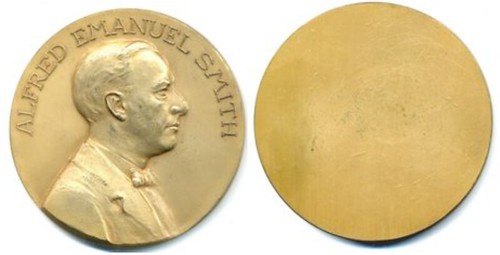
AL SMITH PORTRAIT MEDAL, CA. 1928. 75.5mm. Gilt Bronze. Unsigned. Uniface. Uncirculated with some light spotting throughout. Obv: ALFRED EMANUEL SMITH above a well-modeled portrait of the Happy Warrior to the right. Not much is known about this piece. It is neither signed by the artist or by the mint that struck it. $95.00
CANADIAN GOLD MAPLE LEAF MICRO-ENGRAVED SECURITY FEATURE
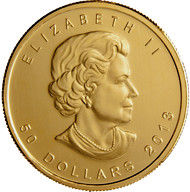
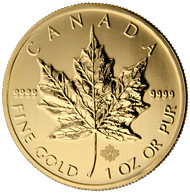
the Royal Canadian Mint’s market-leading Gold Maple Leaf (GML) bullion coin now boasts unprecedented security due to the addition of an advanced visual security feature. An intricately micro-engraved design produced by the Mint’s innovative use of laser technology makes its debut on the reverse “Maple Leaf” side of the 2013-dated 1 oz. GML and will be a permanent addition to the Mint’s flagship gold bullion coin.
“The Royal Canadian Mint is committed to delivering outstanding quality and service to its customers by constantly improving its products through innovation,” said Ian E. Bennett, President and CEO of the Royal Canadian Mint. “By introducing an unprecedented visual security feature to our world-famous Gold Maple Leaf bullion coin, we are proud to offer precious metal investors a gold bullion coin which is a world leader in its security as well as its purity.”
 This new visual security feature confirms the authenticity of all 1 oz. 99.99% pure GML bullion coins produced for 2013 and beyond. Derived from the same ground-breaking security technology applied to Canada’s 2012 $1 and $2 circulation coins, the GML security mark consists of a textured maple leaf, micro-engraved with laser technology on a small area of the reverse (Maple Leaf) side of the coin. In the centre of this mark is the numeral “13” denoting the coin’s year of issue, which is only visible under magnification. As this is a permanent enhancement to the security and integrity of the Mint’s flagship gold bullion product, this laser mark will change annually to feature the last two digits of each corresponding year of issue.
This new visual security feature confirms the authenticity of all 1 oz. 99.99% pure GML bullion coins produced for 2013 and beyond. Derived from the same ground-breaking security technology applied to Canada’s 2012 $1 and $2 circulation coins, the GML security mark consists of a textured maple leaf, micro-engraved with laser technology on a small area of the reverse (Maple Leaf) side of the coin. In the centre of this mark is the numeral “13” denoting the coin’s year of issue, which is only visible under magnification. As this is a permanent enhancement to the security and integrity of the Mint’s flagship gold bullion product, this laser mark will change annually to feature the last two digits of each corresponding year of issue.
To read the complete article, see: Unique Security Feature on Canadian Bullion Coin (www.coinsweekly.com/en/News/4?&id=1623)
ARTIFACTS FROM THE NUESTRA SENORA DE LAS MERCEDES
 A treasure haul salvaged from a sunken Spanish galleon sunk by British warships in 1804 was unveiled today.
A treasure haul salvaged from a sunken Spanish galleon sunk by British warships in 1804 was unveiled today.
The loot was found in the wreck of Nuestra Senora de las Mercedes and had been at the centre of a five-year legal battle between a U.S. salvage company and Spain. US firm Odyssey Marine Exploration found the lost treasure off Portugal's Atlantic coast in 2007. At the time, the treasure was estimated to be worth $500m (£316m).
Only a tiny portion of the haul from the galleon that sank off Portugal's Atlantic coast near the straits of Gibraltar was shown to the media - 12 individual silver coins, a block of encrusted silver coins stuck together after centuries underwater, two gold tobacco boxes and a bronze pulley.
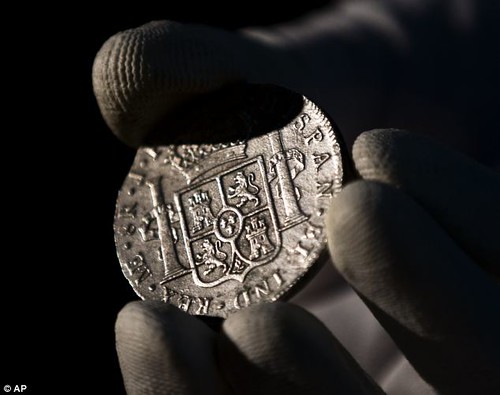
Authorities who have been inventorying the treasure since it was flown from Florida to Spain in February said it will be transferred later this year from Madrid to the National Museum of Underwater Archaeology in the Mediterranean city of Cartagena.
Displays are expected to start next year, with some items put on rotating temporary displays at museums across the country.
The inventory counted 574,553 silver coins and 212 gold coins.
The metals were mined and the coins minted in the Andes, from places that are now in Bolivia, Chile and Peru.
To read the complete article, see:
It may not look much, but this lost treasure fought over by Spain and U.S. salvage firm is worth $500million
(www.dailymail.co.uk/news/article-2241005/Lost-Spanish-treasure
-worth-500million-reclaimed-sunken-19th-Century-galleon-unveiled.html)
Spanish cultural officials allowed a first peek Friday at some of the 16 tons (14.5 metric tons) of shipwreck treasure worth an estimated $500 million that a U.S. salvage company gave up this year after a five-year ownership dispute.
Though previous estimates have put the value of the treasure at $500 million, Spanish officials said they weren't trying to determine an amount because the haul is part of the nation's cultural heritage and can never be sold under Spanish law.
"It's invaluable," said Elisa de Cabo, the Culture Ministry's deputy director of national heritage. "How would you put a price on the Mona Lisa?"
To read the complete article, see:
Nuestra Senora de las Mercedes Treasure Shown For The First Time (PHOTOS)
(www.huffingtonpost.com/2012/11/30/nuestra-senora-de-las
-mercedes-treasure_n_2217132.html#slide=more266851)
IRELAND'S NOISY COIN-CRUSHING MACHINE
The Central Bank has been forced to install sound-proofing because a machine recently installed to decommission old coins is too noisy. The bank routinely removes old and damaged coins from circulation in order the maintain the quality of euro coin.
Until recently, the money-making mint simply stored the coinage. But it has now installed an industrial-sized machine for destroying dud euros.
The machine uses high pressure to crush the coins — a process known as demonitising. After crushing, the coins are melted down.
So far, the machine has crushed a total of €263,279 in spare change. That’s €658,638 in actual coins since unfit coin started to be sent back in 2006.
Now a health and safety review of the machine has established that its noise levels are breaching levels acceptable in a working environment.
According to the Central Bank, "the decibel values of the machine when in operation is in excess of 80db, and the provision of a sound enclosure is required to maintain the safety standard in operation on the Mint production floor".
According to the Central Bank, the humble 2c coin is the coin most likely to find itself taken out of circulation.
To read the complete article, see:
Coin-crushing machine proves headache for bank
(www.irishexaminer.com/ireland/coin-crushing-machine
-proves-headache-for--215115.html)
THE BOOK BAZARRE
INDIA'S ' COIN MAFIA' PROFITS FROM SMALL CHANGE SHORTAGE
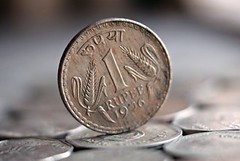 With the current shortage of coins, businesses are forced to cough up huge amounts as payment to brokers who take advantage of the situation.
With the current shortage of coins, businesses are forced to cough up huge amounts as payment to brokers who take advantage of the situation.
It is a ‘small’ problem but a large one for the trader community. Severe shortage of the denomination of Rs.1, 2, and 5 has convulsed the trader community in the twin cities.
A prominent trader in Punjagutta told Postnoon the problem had worsened in the last few months and many commercial outlets have put up a ‘no change’ notice at their counters.
Small businesses are the worst hit. Provision stores and pan shops used to offer chocolates in lieu of Rs.1 but customers resent this. “I need some Rs.5,000 small change every day but I am finding it difficult. The most in demand are coins Rs.1, 2 and 5,” says the owner of a hotel which has branches across the City.
Ali Raza, a restaurant supervisor, said, “Our requirement for small change every month is close to Rs.15 lakh but brokerage charges for supplying small coins has gone up to 20 per cent! This means I get 80 paise for Rs.1. How can we do business?” During Diwali the shortage of Rs.5 coin and note was so much that people had to pay 40 per cent. Small change business has turned into a sort of mafia, he said.
There is a well-established broker network that operates in the twin cities selling small change. Around 15 brokers are always available outside the RBI building. They decide the percentage to be charged. Thus small traders and public are held to ransom. If they spend the whole day before the RBI counter how will they run a business? So most traders pay the brokerage demanded.
To read the complete article, see:
Coin mafia makes money while traders squirm
(postnoon.com/2012/11/26/coin-mafia-makes-money-while
-traders-squirm/90205)
RUSSIA AIRLIFTS BANKNOTES TO SYRIA
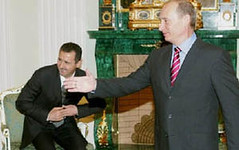 Russia has been helping out embattled Syrian leader Bashar al-Assad by sending him planeloads of cash, newly released flight logs have shown.
Russia has been helping out embattled Syrian leader Bashar al-Assad by sending him planeloads of cash, newly released flight logs have shown.
The logs, obtained by the investigative journalism body ProPublica, showed that an Ilyushin 76 cargo plane belonging to the Syrian Air Force made eight round trips between Moscow's Vnukovo Airport and Damascus over three months this year.
Each time the planes carried stated cargo of 30 tonnes of banknotes, the logs showed.
According to the Independent, this suggests that a total of 240 tonnes of currency, equivalent to roughly 240m notes, made its way from Russia to Syria.
Goznak, the Russian state body that prints banknotes, has confirmed that in recent months it has provided currency to the Syrian regime.
According to the paper, it is unclear whether all the notes aboard the planes were newly minted Syrian currency, or whether there was also some aid in the form of "hard" currency.
In an interview with the state-controlled Rossiiskaya Gazeta last week, the head of Goznak confirmed for the first time that Russia is indeed producing currency for Damascus.
To read the complete article, see: Russia flew 30 tonnes of banknotes to Assad regime, flight logs reveal (www.albawaba.com/business/russia-syria-banknote-452974)
NEW COIN DESIGNS: DECEMBER 2, 2012
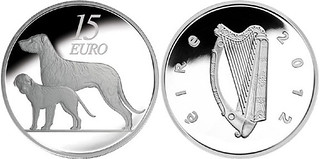
Irish Wolfhound on Ireland's 15 Euro coin
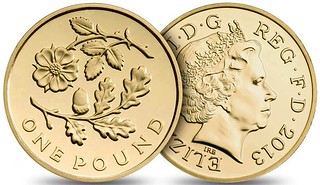
U.K. 2013 One Pound Wales coin
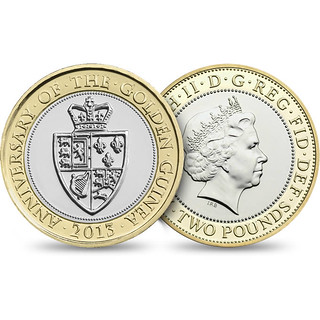
Guinea 2013 bi-metallic 2 pound coin
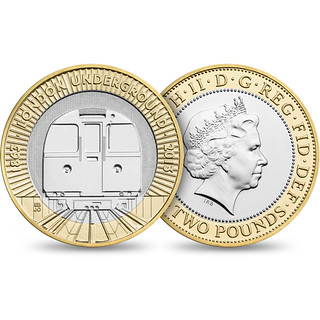
London Underground Commemorative 2013 bi-metallic 2 pound coin

Japan 2013 bi-metallic coins
THE KETT'S REBELLION COIN HOARD
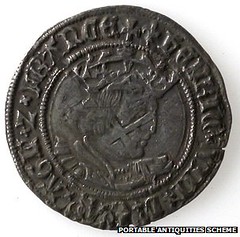 A hoard of coins minted during Henry VIII's reign and found by a metal detector enthusiast in a Norfolk field may have been buried to keep it safe during Kett's Rebellion in 1549.
A hoard of coins minted during Henry VIII's reign and found by a metal detector enthusiast in a Norfolk field may have been buried to keep it safe during Kett's Rebellion in 1549.
The 14 silver groats, found in a field in Wymondham, were pronounced treasure by coroner William Armstrong in Norwich.
Kett's Rebellion during the reign of King Edward VI started in Wymondham.
Dr Adrian Marsden, of the British Museum, said in a report to the coroner it is "quite likely they (the coins) were hidden during the Kett uprising in July and August 1549".
He said the coins "probably represent a small proportion of the hoard originally concealed".
A valuation committee will decide on the value and compensation to be paid to the finder and landowner.
The coins may have been concealed during Kett's Rebellion The rebellion started in Wymondham after a small group of peasants got together to protest against rich robber barons who had stolen the common land, leaving the peasants to starve.
Led by Robert Kett, the peasants marched 10 miles into Norwich and gathered on Mousehold Heath, attracting the support of the poorer people of Norwich.
To read the complete article, see: Kett's Rebellion: 'Hidden' coin hoard declared treasure (www.bbc.co.uk/news/uk-england-norfolk-20547476)
FEATURED WEB PAGE: NUMISTA.COM
This week's Featured Web Page is numista.com, on online coin catalog with over 35,000 coins from 386 countries.
Check your coins against the 35,000 entries of the catalog. Identify your coin using the innovative search engine. A coin is missing? Add it in a few clicks.

en.numista.com
